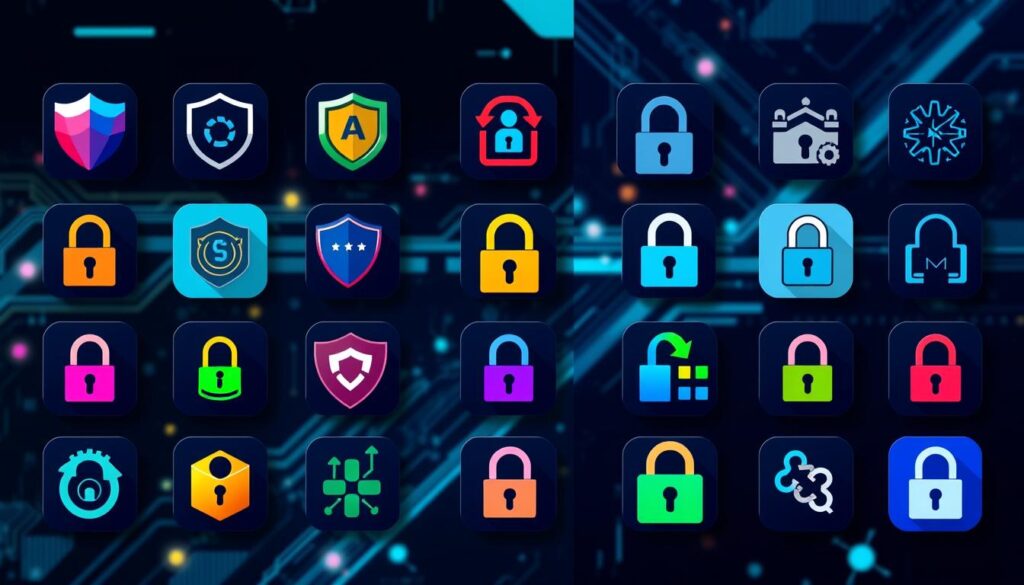FTC disclaimer: This post contains affiliate links and I will be compensated if you make a purchase after clicking on my link.
In today’s world, remote work and cloud services are common. This makes strong identity management very important. With more cyber threats, keeping access to important resources safe is key. But, with many IAM solutions out there, finding the right one for your business can be hard. Are you sure your current identity management is keeping your data safe from breaches and identity theft?
This guide will look at the top 10 identity management software for 2023. We’ll help you choose the best one for your business. We’ll cover the main features, benefits, and costs of each option. This will help you understand the world of identity management better.
Key Takeaways
- Identity management is crucial in today’s digital world, protecting against data breaches and identity theft.
- The top 10 identity management software solutions offer a range of features, including user authentication, access control, and compliance management.
- When choosing an identity management tool, consider your organization’s size, security needs, and how it will grow.
- Good identity management can lower support needs, improve automation, and boost security.
- Keeping up with the latest trends and best practices in identity management is key to protecting your digital assets.
Importance of Identity Management in Today’s Digital Age
In today’s fast-changing digital world, managing digital identities is key for all kinds of organizations. With more cloud apps, remote work, and connected systems, strong Identity and Access Management (IAM) is more important than ever.
Understanding Identity Management
Identity management systems keep track of digital identities and make sure users have the right access. They check who users are, manage their details, and decide if they can access certain things. These systems are vital for keeping data safe and making sure only the right people can see it.
Benefits of Effective Identity Management
- Users get a better experience with Single Sign-On (SSO), easily getting into many apps.
- With Multi-Factor Authentication (MFA), passwords are safer, and attacks are less likely.
- Stronger data security and Access Governance come from having one place to control user access.
- It helps spot and fix security problems early, reducing the damage from data breaches.
In today’s world, where data theft and identity fraud are big threats, strong identity management is crucial. Organizations that focus on this can protect their data, follow rules, and build trust with their people and customers.

“Effective identity management is no longer a nice-to-have, but a must-have for organizations to thrive in the digital era.”
Key Features to Look for in Identity Management Software
Organizations today must protect their data and ensure safe access to systems. Identity management software is key, offering features for user authentication, access control, and compliance. When looking at Identity Lifecycle Management, Privileged Access Management, and Identity Federation solutions, here are the important features to consider:
User Authentication and Access Control
Multi-factor authentication (MFA) and passwordless authentication are vital for security. Look for solutions with various authentication methods. This includes biometrics, push notifications, and hardware security keys to ensure only authorized users access sensitive resources.
Effective Privileged Account Management (PAM) is also crucial. It allows monitoring and controlling users with elevated privileges. This prevents unauthorized access and misuse of critical systems and data.
Integration Capabilities
It’s important for your identity management software to integrate well with your IT ecosystem. Look for solutions with strong Single Sign-On (SSO) functionality. This lets users access many applications and services with just one set of credentials.
Also, comprehensive user provisioning and deprovisioning capabilities are essential. They ensure access rights are correctly granted, modified, and revoked as employees change roles or leave.
Reporting and Compliance Functions
In today’s regulated business world, identity management software must have strong audit and reporting functions. Look for solutions with detailed access logs, user activity reports, and the ability to create customized compliance reports.
By focusing on these key features, you can boost your organization’s Identity Federation, strengthen security, and improve productivity. This ensures regulatory compliance while protecting sensitive data and systems.
| Feature | Description | Benefits |
|---|---|---|
| Multi-Factor Authentication (MFA) | Requires users to provide multiple forms of authentication, such as a password, biometric data, or a one-time code, to access systems or applications. | Significantly enhances security by reducing the risk of unauthorized access and identity-based attacks. |
| Privileged Access Management (PAM) | Provides controlled access and oversight for users with elevated privileges, such as IT administrators, to critical systems and data. | Mitigates the risk of misuse or abuse of privileged accounts, improving overall security posture. |
| Single Sign-On (SSO) | Allows users to access multiple applications and services with a single set of credentials, simplifying the login process. | Enhances user productivity, reduces password fatigue, and improves the overall user experience. |
| User Provisioning and Deprovisioning | Automates the process of granting, modifying, and revoking user access rights as employees join, change roles, or leave the organization. | Ensures that access rights are appropriately managed, reducing the risk of unauthorized access and streamlining user lifecycle management. |
| Audit and Reporting | Provides detailed access logs, user activity reports, and the ability to generate customized compliance reports. | Enables organizations to meet regulatory requirements, monitor user activities, and investigate security incidents. |

“89% of respondents experienced an identity-based attack, according to One Identity’s 2022 Identities and Security Survey.”
The importance of Identity Lifecycle Management, Privileged Access Management, and Identity Federation in today’s digital world cannot be overstated. By focusing on these key features, you can enhance your organization’s security, improve user productivity, and ensure regulatory compliance. This protects sensitive data and critical systems.
Overview of Top Identity Management Software
In today’s digital world, good identity management is key for all kinds of businesses. Microsoft Azure Active Directory and Okta Identity Cloud are at the top. They offer great features and strong security to meet the needs of today’s companies.
Microsoft Azure Active Directory
Microsoft Azure Active Directory is a cloud-based tool for managing identities. It works well with the Microsoft family. It makes Identity Analytics, User Provisioning, and Single Sign-On (SSO) easy for everyone.
It also has strong security like multi-factor authentication. This keeps data safe, making it a top pick for many.
Okta Identity Cloud
Okta Identity Cloud is a top cloud-based Identity Analytics, User Provisioning, and Single Sign-On (SSO) tool. It’s known for its smart security and AI threat detection. It also offers flexible and scalable identity management for all kinds of businesses.
| Feature | Microsoft Azure Active Directory | Okta Identity Cloud |
|---|---|---|
| Identity Analytics | ✓ | ✓ |
| User Provisioning | ✓ | ✓ |
| Single Sign-On (SSO) | ✓ | ✓ |
| Multi-Factor Authentication | ✓ | ✓ |
| Adaptive Security | ✓ | ✓ |
| Scalability | ✓ | ✓ |

Microsoft Azure Active Directory and Okta Identity Cloud are both leaders in identity management. They have strong Identity Analytics, User Provisioning, and Single Sign-On (SSO) features. They are great for companies looking for secure, easy-to-use, and scalable solutions.
Microsoft Azure Active Directory: Key Highlights
Microsoft Azure Active Directory (Azure AD) is a top cloud-based identity and access management solution. It has many features that make it great for organizations. These features help with Cloud-based Identity Management and managing hybrid environments.
User-Friendly Interface
Azure AD has a user-friendly interface. It makes identity management easy. The dashboard gives IT admins a clear view of user accounts and access policies.
It works well with other Microsoft services like Office 365. This makes identity management smoother across the organization.
Security Features
Security is key for Azure AD. It has many features to keep data safe. Multi-factor authentication (MFA) options add an extra layer of security.
Azure AD also supports Hybrid Environments. This lets organizations use their on-premises Active Directory in the cloud. It ensures a secure identity management experience everywhere.
| Feature | Description |
|---|---|
| Single Sign-On (SSO) | Azure AD makes signing into cloud and on-premises apps easy. It boosts productivity and cuts down on password management. |
| Conditional Access | Azure AD’s Conditional Access lets organizations set extra security rules. This includes device checks or risk-based authentication before accessing resources. |
| Privileged Identity Management | Azure AD’s PIM helps manage and monitor access to critical resources. It reduces the risk of unauthorized access. |

Microsoft Azure Active Directory is a great choice for organizations. Its easy-to-use interface, strong security, and integration with Microsoft services are key benefits. It helps improve Cloud-based Identity Management and manage Hybrid Environments well.
Okta Identity Cloud: Overview and Features
Okta Identity Cloud is a powerful tool for managing identities in the cloud. It helps keep digital experiences safe for everyone. It’s perfect for today’s fast-changing business world.
Adaptive Security Measures
Okta’s Adaptive Multi-Factor Authentication (MFA) changes based on how users log in. It uses machine learning to spot and stop bot attacks. It also checks for breached passwords and suspicious IP addresses.
Okta offers more than just passwords. It has Universal Login, Passwordless, and Single Sign-On (SSO). These make logging in easy and secure, without needing to code a lot.
Scalability and Flexibility
Okta Identity Cloud grows with your business. It’s easy to use and doesn’t slow you down. It supports Actions, drag-and-drop integrations, and works in the cloud or on-premises.
Okta focuses on identity management. This helps businesses work better, innovate, and grow. They stay secure and follow the rules.
Comparison of the Leading Identity Management Solutions
Choosing the right identity and access management (IAM) software is key. Look at pricing, how it’s deployed, and the support and resources available. This ensures the IAM solution fits your business needs and budget.
Price and Cost-Effectiveness
IAM solutions have different pricing. Okta offers flexible pricing based on users and features. ForgeRock might cost more upfront but offers customization for big businesses. CyberArk asks for a custom quote, focusing on your specific needs.
Think about the total cost, not just the start-up price. Ping Identity PingOne can be cheaper when bought with other products. Look at pricing and deployment options to find the best IAM for your business.
Customer Support and Community
Good customer support and a strong community are crucial. ForgeRock and CyberArk offer great support and active communities. Okta focuses on self-service, for those who like to handle things themselves.
Check the vendor’s support, like online help and training. A big community can offer valuable advice and tips. This is especially helpful for new users of IAM.
| Identity Management Solution | Price and Cost-Effectiveness | Customer Support and Community |
|---|---|---|
| Okta Identity Management | Flexible pricing based on users and features, with options for customization | Strong focus on self-service resources, with an active user community |
| ForgeRock | Higher upfront implementation costs, but more customization options for large enterprises | Extensive support resources and an active user community |
| CyberArk | Personalized pricing based on specific requirements, encouraging prospective clients to contact sales | Robust support resources and a thriving user community |
| Ping Identity PingOne | More cost-effective when bundled with other Ping Identity products | Offers both self-service and personalized support options |
By looking at price, cost, and support, you can choose the best Identity and Access Management (IAM) for your Enterprise IDM Solutions.
Analyzing Smaller Identity Management Tools
Smaller identity management (IAM) tools are worth looking at. They offer unique features for certain industries or needs. This means more flexibility and options for customization.
Examples of Niche Solutions
Here are some Specialized Identity Management tools with a narrow focus:
- Zluri – Makes onboarding easy with simple triggers and zero-touch setup. It works with identity providers, HRMS, and tech stacks.
- SailPoint – Great for big companies and regulated fields needing detailed access controls and governance.
- Saviynt – Shines in cloud security and access governance. It’s perfect for businesses big on cloud infrastructure.
Pros and Cons of Smaller Tools
Smaller IAM tools have their perks. They offer specialized features, more flexibility, and might cost less. But, they might not work for everyone, have fewer integration options, or lack the depth of big IAM solutions. It’s key to weigh the benefits of specialized tools against the wide range of big IAM platforms.
| Pros of Smaller IAM Tools | Cons of Smaller IAM Tools |
|---|---|
|
|
Choosing an IAM solution means looking at your needs closely. Think about the trade-offs between niche tools and big IAM platforms.
Risks of Inadequate Identity Management
Cybersecurity threats and data breaches often come from weak identity management. When identity and access control are not strong, your organization is at risk. Compromised user credentials are a big reason for data breaches, with 81% of hacking incidents caused by weak passwords.
Consequences of Poor Identity Management
Poor identity management can cause many problems. It can lead to unauthorized access and violate rules. It also makes operations less efficient.
Weak access control and not knowing what users do can let sensitive data get into the wrong hands. This can cause big problems, like service outages, money loss, and harm to your reputation.
Breach Statistics and Impacts
- OWASP’s Top 10 CI/CD Security Risks list inadequate identity and access management as a big worry. It leads to unauthorized access, data breaches, and pipeline tampering.
- The move to CI/CD pipelines makes software releases faster. But, it also brings security challenges, especially in managing identities like service accounts and API keys.
- Challenges in IAM for CI/CD include overly permissive identities and others. These can expose organizations to cybersecurity threats and data breaches.
Strong identity management is key to protecting your organization’s sensitive info. It helps keep operations running smoothly. By tackling the risks of weak identity management, you can improve your cybersecurity. This helps protect your data from unauthorized access and bad activities.
How to Choose the Right Identity Management Software
Choosing the right identity and access management (IAM) solution is key. It protects your digital assets and makes sure users can access what they need. You must look at your Identity Management Requirements and IAM Solution Selection criteria carefully.
Assessing Your Organization’s Needs
First, check your current systems for security gaps. Know who needs access and what they can do. Think about where you’ll deploy the software, how it will grow, and its security features.
Trials and Demos: What to Look For
Use free trials and demos to see how the software works. Look at how easy it is to use and if it fits with your systems. It should make access easier and keep your data safe.
| IAM Solution | Key Features | Pros | Cons |
|---|---|---|---|
| Auth0 | Comprehensive documentation, robust security features, extensive customization capabilities | Highly secure, flexible to meet diverse authentication needs | Can be complex for smaller organizations |
| Microsoft Entra ID | Single sign-on, multi-factor authentication, conditional access, integration with Microsoft products | Seamless integration for Microsoft-centric organizations, strong security features | May be less flexible for non-Microsoft environments |
| CyberArk Idaptive | Combines identity management, enterprise mobility management, and user behavior analytics, advanced machine learning capabilities | Comprehensive security features, proactive threat detection | Can be more expensive compared to some alternatives |
By looking at your Identity Management Requirements and trying out IAM Solution Selection options, you can find the right software. It should meet your needs and keep your data safe.
Future Trends in Identity Management Software
The digital world is changing fast. Identity management software will soon be shaped by AI and automation. Also, there will be more focus on following rules and regulations.
Rise of AI and Automation
AI and automation will change how we fight threats and manage access. We’ll see better ways to spot and stop bad activities thanks to machine learning. These identity management tools will make our digital world safer and smarter.
Increasing Regulatory Requirements
Rules about keeping data safe are getting stricter. Companies will need to show they have strong ways to control who accesses their data. This is to meet demands from places like the Cybersecurity and Infrastructure Security Agency (CISA).
The future of identity management looks bright. AI and automation will make things safer and more efficient. At the same time, following rules will be more important. Keeping up with AI in Identity Management and Regulatory Compliance trends is key for a secure and compliant strategy.
“According to the 2024 CyberRisk Alliance Business Intelligence IAM survey, only 27% of organizations report high levels of confidence that they effectively limit user access to the minimum necessary for their job roles.”
Tips for Implementing Identity Management Software
Implementing identity management software (IAM) needs a good plan and focus on users. To make the transition smooth and get users on board, follow these best practices:
Best Practices for Onboarding
Start IAM rollout in phases. This lets users get used to it slowly and gives feedback. It’s important to talk to users clearly, answering their questions and showing them the benefits.
Make sure to train employees well. This builds their confidence in using the IAM system.
User Training and Support
Supporting users is key for IAM’s success. Offer easy-to-use guides, tutorials, and a quick helpdesk. This makes sure users have a good experience.
Listen to user feedback to improve IAM. This way, you can make the system better for everyone.
By following IAM Implementation and User Adoption Strategies, companies can make their identity management system a success. This leads to better security, more productivity, and following rules better.
| Recommendation | Benefit |
|---|---|
| Implement Multifactor Authentication (MFA) | Enhances security by requiring users to authenticate through two or more methods |
| Adopt Role-Based Access Control (RBAC) | Ensures users have specific permissions based on their assigned roles |
| Reduce Privileged Accounts | Minimizes the risk of cyberattacks and data breaches |
| Implement Zero Trust Security Model | Enhances security measures by continuously verifying user identity and access |
| Implement Single Sign-On (SSO) | Streamlines user authentication processes, improving productivity and user experience |
“Successful IAM Implementation and User Adoption Strategies are vital for organizations to effectively manage user identities, enhance security, and drive operational efficiency.”
Conclusion: Making the Best Choice for Your Organization
When looking at identity management solutions, think about what your organization needs. Consider your IT setup and security needs. Look at how scalable, integrated, secure, and affordable the options are.
Recap of Key Considerations
Choosing the right identity management software is important. Think about your users, the apps and systems you need to connect, and your security and compliance needs. Focus on features like logging in, controlling access, single sign-on, and managing user accounts for a smooth and safe experience.
Final Recommendations for 2023
Our top picks for 2023 are Okta, Microsoft Azure Active Directory, and Ping Identity. They offer strong security, grow with your needs, and integrate well. But, the best fit for you depends on your specific needs and IT setup.








